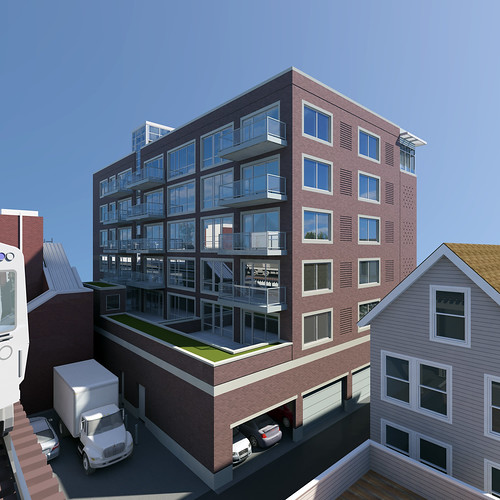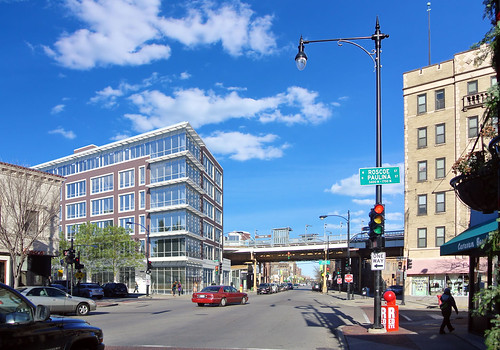For years Chicago’s zoning ordinance, which requires large amount of off-street car parking as part of most new residential buildings, has prevented developers from taking full advantage of transit-friendly locations. However, a transit-oriented development ordinance that passed last year lowers the required number of parking spaces for buildings near transit stations. As Steven Vance reported, Centrum Partners is proposing to build a five-to-seven-story rental building next to the Brown Line’s Paulina stop at 3400 N Lincoln Ave, which would be the first known development to take advantage of the parking minimum reduction.
The building would feature 31 to 48 apartments and 6,000 square feet of first-floor retail, but only nine parking spaces. Under the old rules, one spot would have been required per unit at this location. The TOD ordinance permits including only half as many spaces at buildings within 600 feet of a transit station. To get down to only nine spaces, Centrum has requested a zoning variance from 47th Ward Alderman Ameya Pawar, and Pawar has expressed willingness to do so.
The fly in the ointment is that, much like what happened with the Children’s Memorial Hospital redevelopment, neighbors are pressuring the developer to add more parking to the plan because they are convinced that more housing means more cars, no matter what. It’s important for neighborhood residents who want to see city-friendly, walkable development, not more traffic, to let Pawar know they’re against adding parking to the design. If you live in the ward, contact the alderman at info[at]ward47.org to let your voice be heard and request updates on the project.
Yesterday I caught up with Graham Palmer, one of the principals of Centrum, to hear more about the company's decision to include only a minimum of parking.
John Greenfield: Why did you guys decide to take advantage of the TOD ordinance?
Graham Palmer: The purpose of the ordinance was to spur economic development around transit facilities. Not everybody has a car, and a lot of people want to live near transit. In Chicago, what better place to live than within close proximity of the ‘L’?
JG: Some might argue, “Sure, some people want to live close to the train, but they’re going to need to park their cars as well.” What’s your response?
GP: Statistics show that when you build an apartment near transit, there might be parking spaces, but they’re generally underutilized. Even for buildings far from transit, the one-to-one parking requirements might not really be necessary.
Many people who live close to a train are doing so because they don’t have a car. If you look at listings, housing near transit is more expensive, but people can afford to pay for it because they don’t have the expenses that come from financing a car, gas, maintenance, you name it.
JG: How did you settle on nine spaces?
GP: That’s what the site could accommodate and still work from an economic basis. It was a combination of our beliefs and the constraints of the site itself. We believe this building would have been a success with no car parking.
JG: What’s the status of the project?
GP: The Lakeview Chamber of Commerce and Alderman Scott Waguespack [of the 32nd Ward, which contained the site under the old ward boundaries] have chimed in and they’re very excited about it. Alderman Pawar is awaiting feedback on the project from the West Lakeview Neighbors and the Roscoe Neighbors.
It’s my belief that the opposition is small but vocal. Whether you think including 20 to 25 percent of the usual parking for a project is going to be a problem depends on your point of view. It’s the philosophy that if you live near transit you’re not going to need a car, versus the philosophy that if you’re going to have an apartment, you’re going to have a car, and if you don’t have a parking space you’ll park on the street. As the developer, we’re the ones who are willing to invest a lot of money into this space that doesn’t have parking, and if we can’t lease it, that’s our problem.





